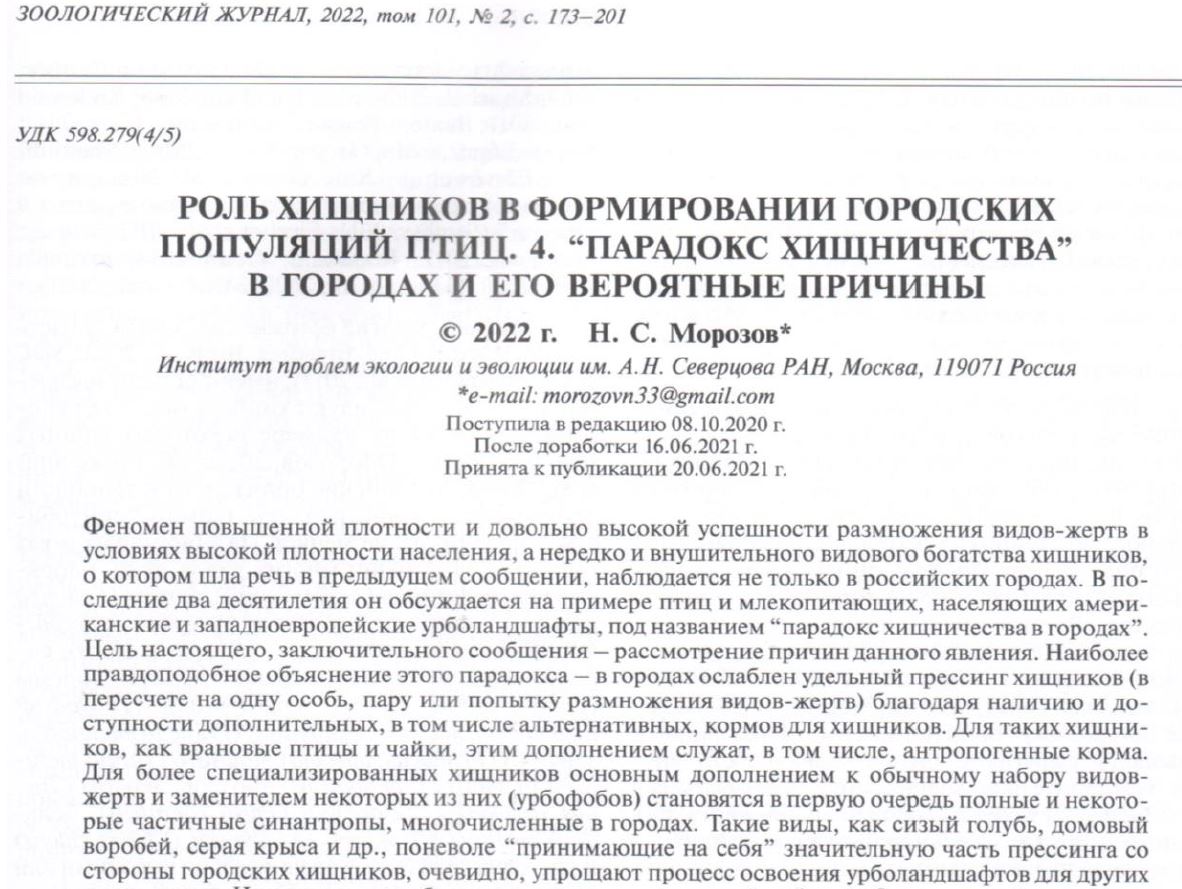Роль хищников в формировании городских популяций птиц. 4. «Парадокс хищничества» в городах и его вероятные причины
Роль хищников в формировании городских популяций птиц. 4. «Парадокс хищничества» в городах и его вероятные причины
Зоологический журнал. 2022. Т. 101. № 2. С. 173—201.
УДК:598.279(4/5), ББК:, ISBN:ISSN: 0044-5134
Феномен повышенной плотности и довольно высокой успешности размножения видов-жертв в условиях высокой плотности населения, а нередко и внушительного видового богатства хищников, о котором шла речь в предыдущем сообщении, наблюдается не только в российских городах. В последние два десятилетия он обсуждается на примере птиц и млекопитающих, населяющих американские и западноевропейские урболандшафты, под названием «парадокс хищничества в городах». Цель настоящего, заключительного сообщения — рассмотрение причин данного явления. Наиболее правдоподобное объяснение этого парадокса — в городах ослаблен удельный прессинг хищников (в пересчете на одну особь, пару или попытку размножения видов-жертв) благодаря наличию и доступности дополнительных, в том числе альтернативных, кормов для хищников. Для таких хищников, как врановые птицы и чайки, этим дополнением служат, в том числе, антропогенные корма. Для более специализированных хищников основным дополнением к обычному набору видов-жертв и заменителем некоторых из них (урбофобов) становятся в первую очередь полные и некоторые частичные синантропы, многочисленные в городах. Такие виды, как сизый голубь, домовый воробей, серая крыса и др., поневоле «принимающие на себя» значительную часть прессинга со стороны городских хищников, очевидно, упрощают процесс освоения урболандшафтов для других видов-жертв. Некоторые синурбисты также становятся частой добычей. Сверх того, абиотическая среда современных городов (электрическое освещение, более мягкий климат, конструктивные особенности зданий) предоставляет хищникам дополнительные возможности для добывания корма. По всей видимости, в некоторых случаях значимый вклад в ослабление пресса хищничества вносят и «виды-покровители» — в первую очередь из числа самих хищников, а также такие, как рябинник. Благодаря их жесткому оборонительному поведению против хищников другие виды, поселившиеся по соседству с ними, оказываются под некоторой защитой. Однако ценотическая значимость «покровительства», особенно в городских условиях, пока исследована слабо.
| Размещено: | 15 Ноября 2022 г. |
| Предоставлено: | Кавказский государственный природный биосферный заповедник |
The role of predators in shaping urban bird populations. 4. The urban predation paradox and its probable causes
ISBN:ISSN: 0044-5134
As concluded in the previous paper, the order of synurbization of predators (Corvus cornix first of all) and prey species, as well as relatively low or moderate proportions of predated nests in some avian prey species in selected Russia’s cities are consistent with the so-called urban predation paradox. The latter, noted for terrestrial vertebrates (mostly birds and mammals) in a number of North American and Western European cities, refers to the predation relaxation of prey species in spite of a simultaneous predator proliferation in urban environments. The most plausible explanation of the paradox is based on the suggestion that the abundance of food for predators is often higher in urban landscapes than in more natural ones. As a result, despite the high densities and considerable species richness of predators, especially generalist mesopredators, the relative predation pressure per active nest or individual prey is hypothesized to be lower in cities than in non-urbanized areas. The food subsidies to predators in urban landscapes are provided (1) in the form of anthropogenic food which can be consumed by predators (especially by generalist predators like corvids, gulls, some carnivores) and/or by their prey species, and (2) through those resources and human activities (e.g. application of organic fertilizers) that increase habitat (primary) productivity in urban green spaces. Initially, dense urban populations of fully synanthropic species such as Columba livia f. domestica, Passer domesticus, and Rattus norvegicus highly dependent on anthropogenic food resources, and also of some partially synanthropic species, e.g. Apus apus and Passer montanus, could have been of prime importance as prey for specialist predators like some birds of prey and owls colonizing cities. By significantly part taking the predation pressure by specialist predators, such prey species might have facilitated the urbanization process for some other prey species. The proportions of some synurbic prey species in the diets of urban predators tend to increase with time as the densities of the former increase. In urban habitats, some predators can also expand the range of the species they prey upon or switch to different prey directly or indidectly due to altered abiotic conditions such as increased temperatures in winter and early spring (enabling an earlier start of breeding in prey and predatory species), artificial light at night (enabling twilight and nocturnal foraging by diurnal birds of prey), and some structural features of buildings (enabling unusual hunting techniques). There are also reasons to suggest that the synurbization of some avian prey species in some cities could have initially been facilitated by nesting in association with aggressive species, e.g. in urban colonies of Turdus pilaris, thus providing protection against predators. However, in general the importance of such associations for the establishment and growth of avian prey population, especially in urban environments, is poorly studied. They are estimates of synergistic effects of predation and other interspecific interactions, especially parasitism, on the success of synurbization that deserve the utmost attention in the coming future.
| Published: | 15 November 2022 |
| Provided: | Caucasus Nature Biosphere Reserve |
23просмотра
15скачиваний
